Puget Systems Serenity SPCR Edition: Blissful Silence
by Dustin Sklavos on February 10, 2011 12:00 AM EST- Posted in
- Systems
- Intel
- Radeon
- Sandy Bridge
- Puget Systems
- Serenity SPCR
Application and Futuremark Performance
At this point it goes without saying that Sandy Bridge is fast, but this time around we have a stock-clocked system contending with both an overclocked Sandy Bridge unit and quite a few systems featuring some overclocked representatives of last generation's finest. While you're looking at these benchmarks, though, try to remember that Puget Systems tuned the Serenity SPCR Edition for maximum silence. The Intel Core i5-2500K hasn't been touched, and the PowerColor Radeon HD 5750 included is tied for the fastest passively-cooled video card on the market. You can hear all of the other systems here under load, but you can't hear the Serenity.
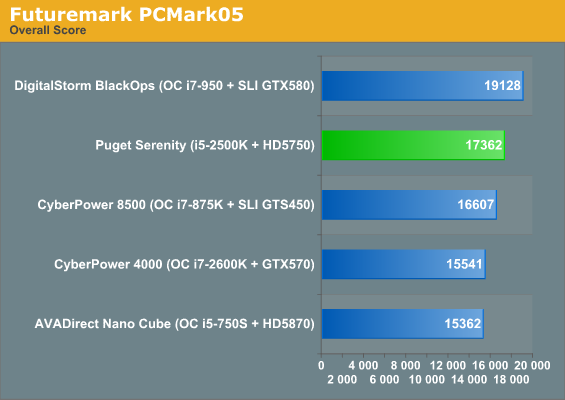
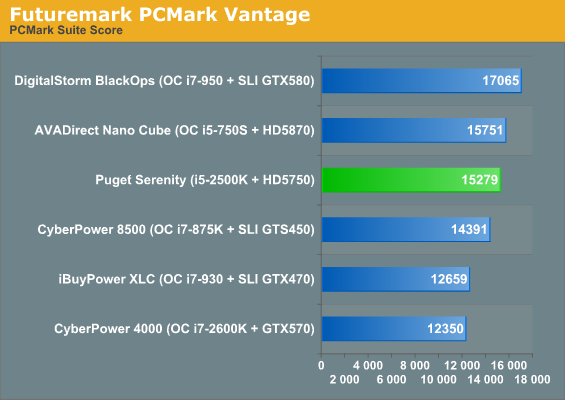
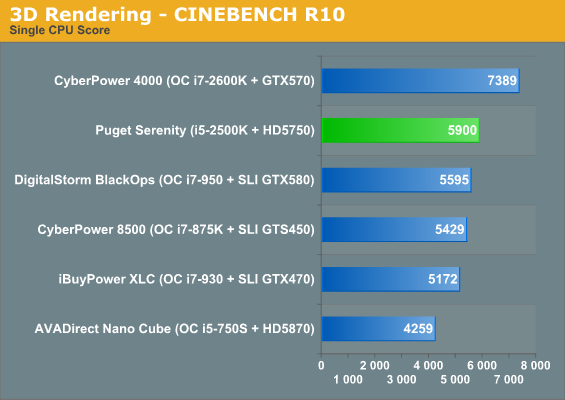
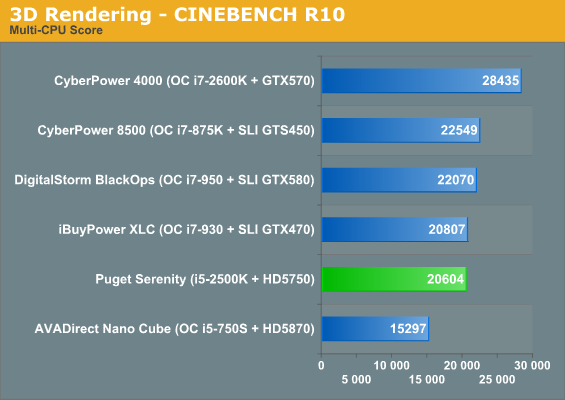
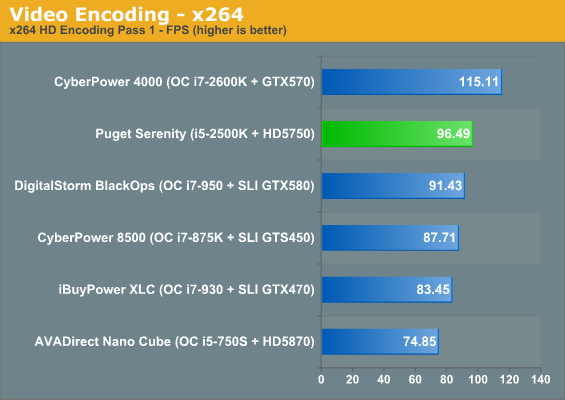

As you can see, even at stock clocks with no Hyper-Threading, it still takes a lot to hold Sandy Bridge down. The DigitalStorm and CyberPower 8500 systems are both running their processors at 3.8GHz, and DigitalStorm's tower has the added benefit of triple-channel memory. In fact the only chips that aren't Hyper-Threaded are the i5-2500K and the i5-750S, and while the i5-750S basically trails the competition here, the i5-2500K's worst showings still mostly nip at the heels of the 3.5GHz processor inside the iBuyPower XLC.
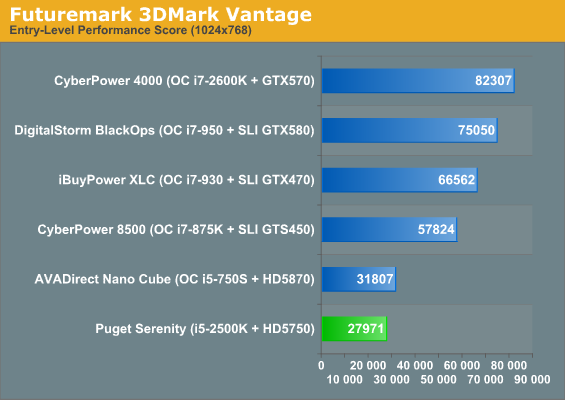
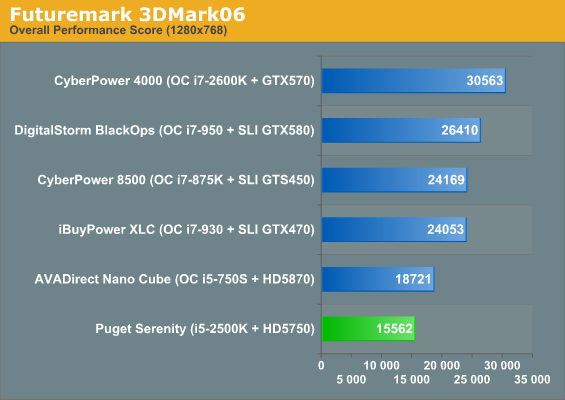

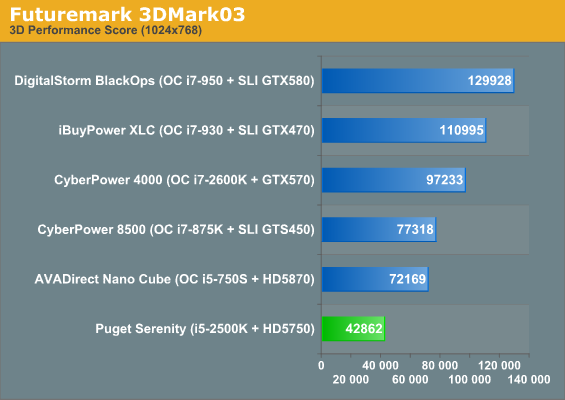
3DMark is less kind to the Puget Systems Serenity, but it still posts a strong showing and as we'll see the 5750 at its heart is for the most part able to game at 1080p. Again, remember that the Serenity is basically inaudible during gaming sessions and power consumption is remarkably low, as you'll see later. Of course, if the 5750 just doesn't cut it for you it's worth repeating that Puget Systems is working on getting a passively-cooled Radeon HD 6850 in house. It's entirely possible that by the time they can start shipping Sandy Bridge-based systems like this one again you'll actually be able to make that upgrade.










139 Comments
View All Comments
MeanBruce - Thursday, February 10, 2011 - link
You don't need an Anechoic Chamber, all you need is a pair of ears in good working condition!Shadowmaster625 - Thursday, February 10, 2011 - link
I have been focusing more on quiet parts for years. But it is really tough to find quiet parts at a decent price. SilentPC review is almost worthless because of the outrageous prices of the parts that they review. sigh.HangFire - Thursday, February 10, 2011 - link
Huh? Do you have examples?WD Green drives are hardly pricey. You only need one or two CPU fans, so while $19 each may be "twice the price" of a noisy fan, it is still not a lot of money. I picked up my Mugen 2 for $55 plus shipping, and better deals have been had for that item. It works so well I had to turn off the BIOS alarm because the PWMA CPU fan kept dropping below 100RPM and the CPU idles 2C above ambient. A P183 costs less than most Lian Li's and certainly a lot less than a ThermalTake Level 10. Since most silent builds don't use a big card like a GTX 580 the total system costs are usually less than a mid-range gaming rig.
The only nearly "pricey" item I can see at SPCR is the Seasonic X-400 Power Supply. Given that you are getting a Gold Rating and fanless operation, in a P/S with a long warranty and very high quality capacitors, with low ripple and tight regulation, it is obvious you are getting what you pay for. The overall system longevity and reliability is worth it, especially compared to bargain gaming power supplies, many of which have false ratings. If you are comparing it price-wise to a same-wattage low end Rosewill or a Diablotek, well, anyone who buys something like that gets what they deserve when the magic smoke comes out.
Shadowmaster625 - Friday, February 11, 2011 - link
I'm mainly thinking of power supplies and fans. In the case of fans, a few years back I bought one they recommended and it wasnt nearly as quiet as I expected. Things could be different now but I feel like an idiot dropping $20+ on a fan anyway.With power supplies, I was looking for a good quiet reasonably priced 300W supply. Something that is only going to be powering a dual core with 2 drives and a HD5670. Nothing big. And when I did find one, I would go to newegg and the thing would have a horrible rating with lots of DOAs and "died after 2 weeks" type comments. It is hard to pull the trigger and pay $60 for a 300 watt psu that people are having problems with. I think $60 is pretty steep for a 300W supply, even if it is very quiet. If I pay that much I want it to be a 5 star product.
HangFire - Monday, February 14, 2011 - link
SPCR is the place to go for noise reviews. For Power Supply quality reviews, there is jonnyguru and [H]ardOCP. Not Anandtech, and certainly not Tom's.Just a few years ago, buying a quality power supply for a decent price was very difficult. Part of the problem is that it costs almost as much to build a 300W P/S as a 600W (same number of components, same labor, same shipping, same marketing, same return rate, slightly different rating on components), yet the market will not pay as much. Since then, competition (mainly between Antec and Corsair) has given us several reasonable choices.
The existence of $15 power supplies colors the users opinion as well, and the existence of $15 P/S that sell for $60 doesn't help either. Keeping in mind that cheap P/S often are missing advertised features (like Over Current Protection), don't meet ATX specs (typically voltage regulation at rated wattage), and are missing A/C filtering components (lots of noise put back on the mains). Getting all this stuff right costs money. Doing it very quietly costs more.
As for loud fans and a dead P/S, everyone has bad luck, that is what RMA's are for. Sure, we are usually out the shipping, but we can let our displeasure be known in reviews and forums, and by buying the competitor's products.
But your idea that SPCR is almost worthless and reviews primarily outrageously expensive products is silly. Compared to cutting edge performance products, almost everything on SPCR is cheap.
PartEleven - Thursday, February 10, 2011 - link
I frequent SPCR, and I have no idea where you got this opinion. They suggest some of the most reasonably-priced parts out of all of the tech sites I've read. Which parts are you looking at? And for that matter, what's your idea of "reasonably priced"? You're not going to get quality quiet parts for the bargain-basement $1 per fan price you find on deal sites.Golgatha - Thursday, February 10, 2011 - link
They replaced some case fans, used an aftermarket cooler with a more silent fan, and cut some foam to fit inside an Antec case. This + service (last I checked the individual components are warrantied by the manufacturers) != a $1000 markup. Also, at this price point it should come with a SSD.Golgatha - Thursday, February 10, 2011 - link
Sorry, my mistake, it does some with a SSD. Still the parts list is lacking for the price they want.HangFire - Thursday, February 10, 2011 - link
Wow, you made the same point as Dustin, and even got the cost differential wrong the same amount, too. Good job!KayDat - Thursday, February 10, 2011 - link
I guess that means you don't fall under Puget's target market. There are certain markets where silent computer is important. Noise is often a forgotten aspect when people build computers, basically as long as it doesn't sound like an outright vacuum cleaner/blow dryer, people accept it.While you could buy identical parts for much much cheaper, they cherry pick their parts to iron out batch variation and electrical noise in motherboards and power supplies. They have anechoic chambers for testing. The list goes on. Clearly, it's not something an average Joe can do off New Egg. That might not mean much to many, especially the readership of AT, but it is important to some.